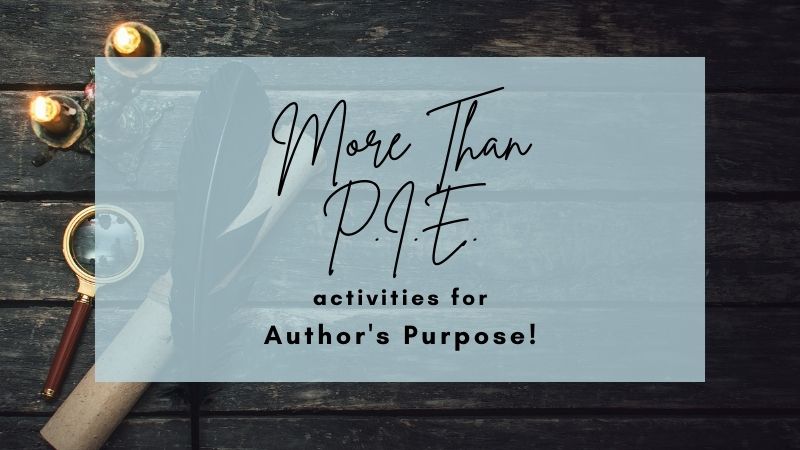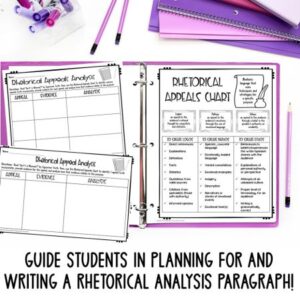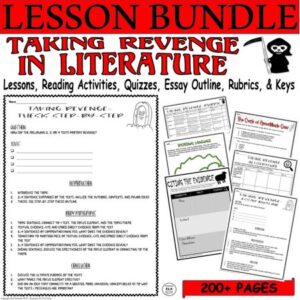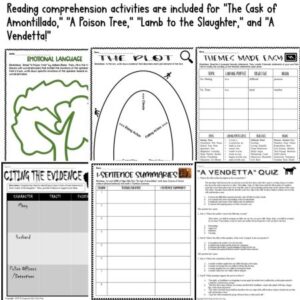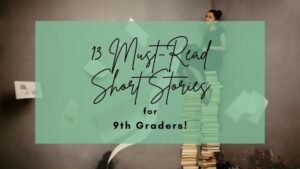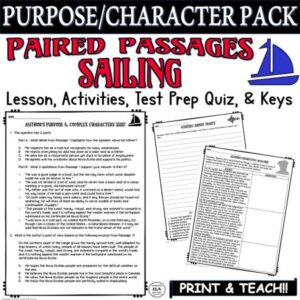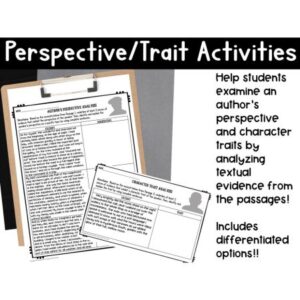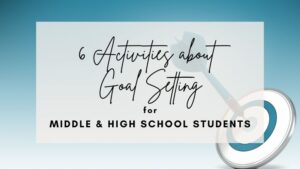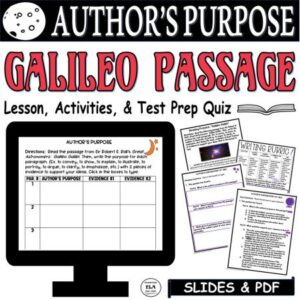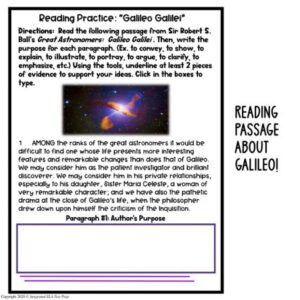In elementary school, the question of the author’s purpose tends to tie into pie. Not a delicious pie to eat but rather P.I.E., an acronym of the three purposes for any given text: Persuade, Inform, Entertain. However, we know as readers and teachers that things are a bit more complicated than that. There’s more than just those three purposes, and there’s crossover in between too! And this is the part where high school teachers, through activities for author’s purpose, get to expand on those early lessons to help develop students’ skills.
Establishing author’s purpose, much like other standards such as finding the central idea or citing evidence, is important because it helps to grow literacy skills and makes our students better readers. These skills become transferable across texts, within courses, and throughout the high school years!
Need help with Reading Test Prep? Check out this FREE Pack of 3 Test Prep Activities to help upper middle and high school students achieve success on standardized tests!

What is Author’s Purpose?
Students need to explore the author’s purpose beyond P.I.E., beyond a mere desire to persuade, to inform, or to entertain. As students move from elementary to middle and high school, we want them to dive more deeply into what the author hopes to achieve in connecting to his/her audience of readers.
At its simplest, an author’s purpose is the hope that the audience will understand the work and then do something, change their thinking, take action, reject or defend, and so on. It really is so much more than P.I.E.! You can check out a full list of possibilities in this verb chart for writers. This reference list is helpful during reading activities for comprehension and activities for the author’s purpose.
The best part about exploring an author’s purpose in middle and high school is figuring out that a text can have multiple purposes. For example, a news article could inform the audience about an issue in order to convince the audience to take action. It can also discuss satire a bit or make use of rhetorical analysis to startle or surprise. The purpose can be multi-dimensional, and supporting students in discovering that there can be more than one purpose is another way to broaden their literacy skills.
Click below to get “Ain’t I a Woman?” activities for author’s purpose to help with rhetorical analysis!
Qualities of Good Reading Passages To Help with Teaching Activities for Author’s Purpose
When including activities for author’s purpose, there are several qualities you’ll want to take into account to ensure good reading passages.
Check out these seven qualities that, in combination, can provide a solid foundation for judging selections to include in your activities for author’s purpose.
- Varied Vocabulary – You want a text that is neither too challenging nor too simple. You want vocabulary that can help to grow students’ skills so they may recognize additional ways to communicate purpose.
- Range of Syntax – With passages that feature a range of sentence types and structure, students can explore rhetorical and aesthetic choices in texts. This can easily increase the challenge for readers.
- Selection of Different Passages – Provide passages at different reading levels: high, low, and in-between. This variety provides different ways authors may incorporate their purpose.
- Difference lengths – To start, choose short texts to ensure students’ understanding of the author’s purpose, but as their abilities develop, so too should students’ stamina in reading longer texts. This is helpful as requirements for reading continue to develop during the school year. Plus, practicing with different lengths provides helpful training for state standardized testing.
- Fiction/Nonfiction – Adding in variety will help students to recognize that author’s purpose is not tied to form and genre. Not all fiction is designed to entertain, just as all nonfiction doesn’t just inform. Providing options within these categories can reinforce that the author’s purpose is more than just P.I.E.; it is multi-dimensional.
- Modern and Classical Texts – With modern texts, students can flex their knowledge base and with classical texts, students can work on transferring knowledge. In each instance, it requires a distinct skill set, and it provides a diversity of content and writers, too!
- Texts from different cultures/time periods – As an extension of modern and classical texts consider options from different cultures and time periods. This selection can reflect the learners in your class or provide them with a window into varied experiences. A great way to make this happen is by using thematic units. Check out this unit based on REVENGE!
Want some AWESOME short story ideas? Click HERE!
Types of Texts and Activities for Author’s Purpose
Now, in stating that there is more than just P.I.E., how do we help our students recognize that there are more than these initial three types of purposes for authors?
The answer is in choosing passages and activities for author’s purpose that reflect the qualities listed above, but that’s often easier said than done.
Click the pack below to get help with easy to teach reading test prep materials for paired texts!
To help you make suitable, effective, and relevant choices, here are 7 types of texts for exploring author’s purpose that you can use in your middle or high school English classroom.
The best part is the variety of options and the ability to incorporate both fiction and nonfiction into the mix of activities for author’s purpose!
- Narratives – Using nonfiction, especially informational texts, is a good starting point since it’s easy to build on the basics of P.I.E. (persuade, inform, entertain) that students already know. Once the foundation is established and reviewed, these texts can be made more challenging to get students practicing beyond P.I.E. This narrative passage and author’s purpose activities might just be the solution for your next step!
- Poetry – This one may seem like a challenge since poetry is often difficult for students. However, if you get students to focus on vocabulary and word choice to figure out tone then you’re halfway to finding the author’s purpose in connection to the theme! Check out this lesson that’s print and go!
- Paired Passages – When you want to increase the challenge a bit, try paired passages. You can get students thinking about ways that the same text can have multiple purposes. Pairing texts also opens up possibilities for comparison with authors’ purposes too! Skip finding your own pairings and get your ready-made lesson here.
- Fictional Texts – Using fiction in part or as whole texts is a way to combine studying fictional elements such as point of view with reading activities to uncover the author’s purpose. Use these within your class novel studies or with short stories you’re reading in class. Grab a copy of these reading activities focused on excerpts from Mark Twain’s fiction for your classroom.
- Scientific or Historical Texts – If you’re looking to expand activities for author’s purpose options for what you teach in class and meet the lesser-covered interests of your students, use scientific or historical texts. Examining vocabulary in context and considering time and place with some background knowledge exploration can make this text type a real winner! Try options like this one about Pearl Harbor.
- Biographies or Autobiographies – Another option for nonfiction is stories of real people. Use these as a way to build background knowledge or extend learning for upcoming lessons you’re already set to teach. Here’s a lesson about Sir Isaac Newton that works on several levels including as an informational text!
- Myths/Legends/Origin Stories – Including these types of stories can be a hook for students since myths and legends tie into so much of our current pop culture. These stories are another way to provide dimension to what students learn in English. Finally, incorporating myths, legends, and origin stories from around the world means you’re including more diverse texts and voices in your classroom – a win-win! Check out this lesson about Kobodaishi, a great Japanese writer/scribe.
Need activities for author’s purpose to explain both purpose, perspective, and characterization? Click the image below!
Craving EASY print and teach activities that will save your sanity for back to school? Click below for 6 activities about goal setting!
Why should we include activities for author’s purpose in middle and high school?
As with all reading activities, include those activities for author’s purpose, in your middle and high school English class, using good literature is integral to engaging students, expanding their interests, and developing their literacy skills.
By including activities for author’s purpose, you give students the possibility of more depth in their study of any given text. Through these activities for author’s purpose, they can see the role that good literature plays in people’s lives.
Beyond just P.I.E., students can then understand that good literature can affect people in so many ways. That lesson can be quite powerful! And isn’t that just an absolute bonus of being an English teacher? It might even beat a piece of delicious pie… almost!
Need more fun reading test prep lessons and worksheets that incorporate activities for author’s purpose? Check out my store Kristin Menke-Integrated ELA Test Prep!

